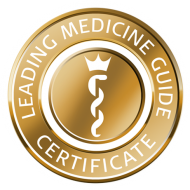Recommended specialists
Article overview
In which specialist field are hemorrhoid specialists active?
Hemorrhoids, which are commonly known as piles, occur as vascular structures in the area of the anal canal. When present in their usual condition as pillow-like clusters of veins, they function as cushions that facilitate stool control. However, the term "hemorrhoid" specifically describes these same structures in their diseased state when they have become swollen and inflamed – a condition to which they are often prone due to their rich blood supply.
Hemorrhoid symptoms will typically be referred to a family physician or a similar general practitioner. However, if complications occur, it may be necessary to refer the case to other specialists. These may include one or more experts from the fields of cardiovascular disease, or diseases of the digestive system, including:
- a hemorrhoid specialist, whose training specifically relates to this type of disease
- a gastroenterologist, who deals with diseases of the digestive system
- a proctologist, who treats disease in the rectum, anus and colon
- a colorectal surgeon, whose specialism is surgery within the rectal area of the digestive system
- a vascular surgeon, whose focus is diseases involving blood vessels
- an oncologist, whose opinion may be sought if there is a need to investigate a possible cancer
Which illnesses do hemorrhoid specialists treat?
There are two different types of hemorrhoids that can exist together, namely:
- internal hemorrhoids, which will be located in the lower rectum
- external hemorrhoids, which can occur under the skin immediately around the anus itself.
The most discomforting type are the external hemorrhoids because the overlying skin in this area, which is sensitive to pain and temperature, can soon become irritated and tends to wear away. If a blood clot should then form inside an external hemorrhoid, the pain is often sudden and can be severe. There may be a lump in the anal area, which can be felt or seen. The clot then typically dissolves, leaving a skin tag (a flap of excess skin) which may often itch or become irritated.
Unlike the external type, internal hemorrhoids are typically painless, even if they produce bleeding. Thus, you may notice bright red blood on the toilet paper, or else blood dripping into the toilet bowl. In addition, internally forming hemorrhoids can also prolapse, and thus extend beyond the anus. This can result in a number of potential problems because a protruding hemorrhoid may then collect microscopic stool particles and small amounts of mucus. This may then cause an irritation, which is called pruritus ani, and constantly wiping in an effort to relieve the itching may simply make the problem worse.
Based on the degree of prolapse, a standard medical classification recognises the following four grades of prolapsed hemorrhoid:
- Grade I: No prolapse, just prominent blood vessels
- Grade II: Prolapse upon bearing down, but spontaneous reduction
- Grade III: Prolapse upon bearing down, requiring manual reduction
- Grade IV: Prolapse with inability to be manually reduced
What treatment methods are used by hemorrhoid specialists?
A visual examination by a primary care doctor is often enough to diagnose a simple case of hemorrhoids, which can then be treated by using:
- corticosteroid cream, which can help to reduce swelling and pain
- hemorrhoid cream containing lidocaine, which helps to reduce pain
- stool softeners designed to minimise straining and constipation
Other useful home treatments include:
- applying witch hazel with a cotton swab
- wearing cotton underwear
- avoiding perfumed and coloured toilet tissue
- avoiding scratching the area
- using a warm-water Sitz bath to relieve the symptoms
In more complex cases, these treatments may not be enough to cure the problem. Where surgery is a recommended option, it will usually involve one of these procedures:
- banding, or rubber band ligation, is used to cut off the blood supply to a hemorrhoid, which then withers away.
- sclerotherapy is a procedure that injects a chemical into a hemorrhoid. As a result, the hemorrhoid will reduce in size and stop bleeding. Sclerotherapy is typically used for smaller, internal hemorrhoids.
- coagulation therapy, or infrared photocoagulation, uses sources such as infrared light, heat or extreme cold to shrink the hemorrhoid.
- a hemorrhoidectomy may be required for a larger external hemorrhoid, or a prolapsed internal hemorrhoid. This procedure will require an anaesthetic.
- hemorrhoidopexy, often described as stapling, is performed under anaesthetic. Typically used to repair a prolapsed hemorrhoid, the procedure staples the tissue inside the rectum so the surgeon can then cut off the blood supply. This causes the hemorrhoid tissue to shrink.
What additional qualifications are required by hemorrhoid specialists?
After finishing medical school, a hemorrhoid specialist will complete a four-year residency in order to train in a major discipline, such as the vascular field or in gastroenterology. Once licensed to practice in one of these fields, a hemorrhoid specialist must then undertake a two-year fellowship to acquire the skills and specialist knowledge this area of medicine demands.

























